Fannin County History
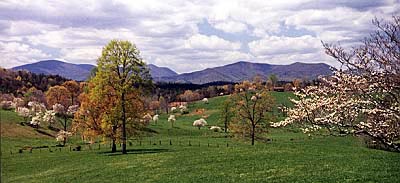 Fannin County was approved as its own entity, by
the State of Georgia in 1854 from parts of Union and Gilmer County.
The town of Morganton was the site for the Fannin County seat. Farm
communities and modest towns were quickly becoming permanent fixtures
within the county. Fannin County was approved as its own entity, by
the State of Georgia in 1854 from parts of Union and Gilmer County.
The town of Morganton was the site for the Fannin County seat. Farm
communities and modest towns were quickly becoming permanent fixtures
within the county.
Controversy arose
in Fannin County when the railroad proposed to build a rail line through
the mountains. Morganton felt the railroad should naturally go through
the county seat, the railroad didn't feel that Morganton provided the
best route. Although much controversy erupted before the final decision,
the railroad chose another location for the railroad hub. 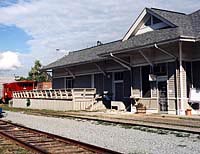 As
a result of this decision, the town of Blue Ridge came into being, and
was incorporated in 1887. Blue Ridge took its name from its location
at the southern gateway of the Blue Ridge Mountains. As
a result of this decision, the town of Blue Ridge came into being, and
was incorporated in 1887. Blue Ridge took its name from its location
at the southern gateway of the Blue Ridge Mountains.
The future had arrived
in Fannin County as of 1889, the railroad would carry passengers supplies
and modern convenience to this new frontier, while hauling raw materials
from the mountains to the low lands.
Blue Ridge became
a boom town as a result of "the great iron highway." Entrepreneurs,
investors and tourists headed to North Georgia in the late 1800's and
early 1900's, for much the same reason they do today. Visitors flocked
to the mountains, to get away from over crowded cities, and stay in
one of the many hotels or summer homes, not just for a weekend but for
longer periods of recuperation.
Mineral potions were
the rage during this era, and Fannin County had pure mineral springs.
These springs' boast of rejuvenating powers for all your ailments. Many
people attested to the curative properties of the mineral springs and
their own personal healing miracles. Most felt it was a combination
of good water, fresh air, wholesome foods and the lack of stress offered
by the beautiful landscapes and the laid-back mountain lifestyle. Visitors
returned home after each visit with a fresh outlook and they have been
returning seasonally for over 100 year.
All attention was
on Blue Ridge during this time. Hotels and inns sprang up along both
sides of the tracks as well as restaurants, dry goods stores and stables.
A railroad hub-machine shop was built in Blue Ridge, employing a large
numbers of people from the county. Prominent homes were being built
along with schools and churches. This growth required Fannin County
to eventually move its county seat to Blue Ridge for convenience sake
in 1895.
Over the next dozen
years, travelers from Atlanta and Knoxville came to this popular luxury
resort and health spa area, by the droves. The demands were so large
that the railroad had to add "extra" and "special"
passenger trains to an already busy rail line.
An 1887 newspaper
article in from the neighboring town of Ellijay, gives us a view of
the activity that was present during the birth of Blue Ridge, the railroad
and the mineral spas.
"Its hills that
jut up in mid air kiss the first rays of the morning sun and are fanned
by an undisturbed breeze. Fannin County stands at the head of the list
of American counties for health, the mortality being only five percent.
As a health resort, it stands without superior and those who are disposed
to invest capital that way are not slow to perceive its splendid inducements.
There are also a
number of mineral springs in the town that deserve more than a passing
notice. Lots are being sold almost every day, and on last Tuesday seventeen
lots were sold, and as captain Frank Walton remarked, "It wasn't
much of a day for selling lots, either." People from all over the
state and many without are investing in Blue Ridge dirt, if for no other
purpose than to await future development. More could be said in this
article, but we wait for another issue.
With a $700 church,
a $1,000 Academy, a $40,000 hotel, and other attendant improvements,
we see no reason why Blue Ridge, with all her mineral wealth and her
health given chalveate water, may not yet bloom out the pushing town
of North Georgia Messers. McKinney and Walton, who own the real estate,
intend to make a town of that place whether fate so decrees or not."......The
Ellijay Courier, 1887.
Visions for a great
mountain city were born out of raw forest, mineral springs, iron rails
and a lot of capital investments. Blue Ridge was preparing a great stage
for the "Gilded Age," high society, social fare, good health
and daring investments. During this era the town of Blue Ridge grew,
not by humble abodes, by homes of substantial means. Visionaries and
idealist thought they were on their way to building a new Utopia.
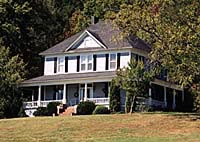 Up the rail line from Blue Ridge was Mineral Bluff,
another Fannin community, known for its inspirational water and spa
retreats. Mineral Bluff pre-dates the railroad and grew quickly to accommodate
the accelerated growth. Over time, Mineral Bluff drifted quietly back
into the Up the rail line from Blue Ridge was Mineral Bluff,
another Fannin community, known for its inspirational water and spa
retreats. Mineral Bluff pre-dates the railroad and grew quickly to accommodate
the accelerated growth. Over time, Mineral Bluff drifted quietly back
into the  tranquil little community that it is today. tranquil little community that it is today.
In 1906, the railroad's
machine shops were moved further up the line into Tennessee, the progressive
momentum of Fannin County was beginning to slack. The hordes of mineral
mining was running thin. By the 1920's, 80% of the ancient forest was
lost to loggers, land clearing or disease. Copper mining defoliated
60,000 acres before its halt, some of which were in northern Fannin
County, although the majority of the copper mining was done in the southeastern
corner of Tennessee.
The demand for raw
materials seemed inexhaustible, the land yielded its bounty, and had
no defense. Vast land tracts were barren and in need of replenishing,
nurturing and preservation, a great atrocity had been committed. In
the end, the users and 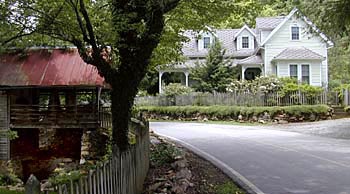 takers
had to turn their less than conscientious pursuit into a conscience
awakening. takers
had to turn their less than conscientious pursuit into a conscience
awakening.
In the southern high
mountain valley of Fannin Country, along the subtle banks of the Toccoa
River, is a mountain farm community named Dial, Georgia. Founded
in 1834, Dial was one of the first communities settled in this region.
The charm of this community, is that there's no town. Small farms and
a hand full of modest homes dot the fields and river banks. There are
also landmark constructions of barns, out buildings, a large double
decked porch farm house and quaint Victorian farm house to mention a
few. This community hasn't' seen a change in over 100 years, lets hope
it never does.
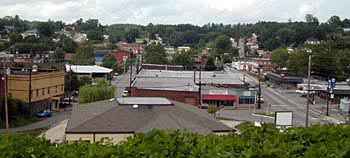 McCaysville is a classic river town on the border
of Georgia and Tennessee. The railroad and copper mines put this town
on the map. Copperhill Tennessee is directly adjacent to McCaysville,
unifying the two river communities as border towns or twin cities. McCaysville is a classic river town on the border
of Georgia and Tennessee. The railroad and copper mines put this town
on the map. Copperhill Tennessee is directly adjacent to McCaysville,
unifying the two river communities as border towns or twin cities.
The history of these
two towns have seen a seesaw of growth, natural disasters, economic
wealth and failure. Presently the twin cities are proud of the comeback
wave it is now experiencing at the close of this Century.
Just south of McCaysville
you'll find Epworth, originally a farm community, mostly residential
today with an old country store, definitely worth checking out, and
post office. Epworth is located on the route between Blue Ridge and
McCaysville.
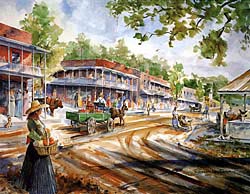 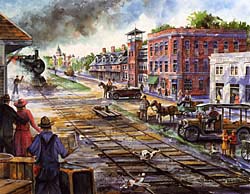
Paintings by Richard Lowe Evans,
courtesy of the Blue Ridge Arts Association and Mrs. Dot Evans. Prints
and note cards are available for sale at the Blue Ridge Arts Association.
More on Fannin County
Fannin County, Blue Ridge, Morganton, Mineral Bluff, McCaysville, Dial, Epworth, Aska Adventure Area Community Profile
Gateway to the Mountains, editorial on Fannin County and Blue Ridge Georgia |

 Fannin County was approved as its own entity, by
the State of Georgia in 1854 from parts of Union and Gilmer County.
The town of Morganton was the site for the Fannin County seat. Farm
communities and modest towns were quickly becoming permanent fixtures
within the county.
Fannin County was approved as its own entity, by
the State of Georgia in 1854 from parts of Union and Gilmer County.
The town of Morganton was the site for the Fannin County seat. Farm
communities and modest towns were quickly becoming permanent fixtures
within the county. As
a result of this decision, the town of Blue Ridge came into being, and
was incorporated in 1887. Blue Ridge took its name from its location
at the southern gateway of the Blue Ridge Mountains.
As
a result of this decision, the town of Blue Ridge came into being, and
was incorporated in 1887. Blue Ridge took its name from its location
at the southern gateway of the Blue Ridge Mountains. Up the rail line from Blue Ridge was
Up the rail line from Blue Ridge was  tranquil little community that it is today.
tranquil little community that it is today.  takers
had to turn their less than conscientious pursuit into a conscience
awakening.
takers
had to turn their less than conscientious pursuit into a conscience
awakening.









